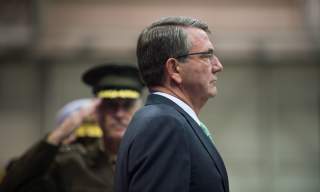Defense at a Time of Strategic Transition
America’s defense posture at the moment of the Obama-Trump handoff.
We’re also innovating operationally in our operations plans. Our core contingency plans are constantly being changed to apply innovation to our operational approaches—including ways to overcome emerging threats, such as anti-satellite weapons or hybrid warfare. We’re building in modularity, planning in new ways for overlapping contingencies, and injecting agility and flexibility into our war plans.
Meanwhile we’re making reforms across the DoD enterprise—streamlining our headquarters operations, lowering our health care costs, continuing to improve our acquisition process, and more. We’re also continuing to support and seek improvements in the spirit of Goldwater-Nichols—which Sam Nunn had so much to do with—among other changes, to clarify the role and authority of the Chairman, and the Joint Chiefs, and the Joint Staff, and to help our Combatant Commanders be more efficient and agile and support me and the President, especially in the face of transregional and transfunctional challenges.
And we’re ensuring DoD’s a place where thinking boldly and differently is fostered. One way we’re doing so is with the Defense Innovation Board I established last year, chaired by Google-Alphabet’s Eric Schmidt. Its members are already making a mark. For example, on their recommendation, we have now a Chief Innovation Officer, which many companies have, by the way, to act as a senior advisor to the Secretary of Defense.
And lastly, and importantly Sam alluded to this, we’re building what I call the Force of the Future . . . to ensure that amid generational, technological, and labor market changes, we continue to attract and retain and develop the most talented people America has to offer, for what is after all an all-volunteer force.
In total, the Force of the Future initiatives span the career of a uniformed service member or DoD civilian—from recruiting men and women to join, to caring for, retaining, and developing them, and then to helping successfully transition those who want to move on.
And these initiatives include reinvigorating and expanding the geographic reach of our Reserve Officers’ Training Corps program, which by the way just had its 100th birthday last year; making common-sense improvements to military talent management and officer promotion; giving components the authority to directly hire civilians on college campuses—this is a big deal if you remember your mind-set in college; recognizing survey data indicating the importance of family life to retention—bearing in mind that our force is largely a married force—by expanding maternity and paternity leave and extending on-base childcare hours, and other steps of this kind.
And also, ensuring that DoD must be able to draw from 100 percent of the American population . . . and to compete for the best we must select the best based solely upon their qualifications to meet our high standards—not race, not gender, identity, sexual orientation—but rather, focusing on whether someone can meet our standards as the best person for the job.
Conclusion
In conclusion, because we’re doing all this, because DoD’s changing, and adapting, and innovating, because of our nation’s enduring strengths, I’m confident that its future is bright and that there are many opportunities for our country to seize.
But I can never forget—and we can never forget—and I’m even more mindful as my days as Secretary of Defense grow short, about who makes it all happen: it’s DoD’s people.
Each of our servicemembers and DoD civilians makes me proud, incredibly proud. There are almost 3 million of them serving across this country and around the clock, in every time zone on earth, in every domain—in the air, ashore, afloat, and even in cyberspace—all in service of this great nation.
All of them are defending not only the United States and its people; they’re also defending the values and the principles that define us, while they provide the security that will enable our children to live a better life.
Because they do so, we can gather here in safety and celebrate Sam Nunn. We can go to work tomorrow or study at one of America’s world-class universities. We can live our lives and dream our dreams and enjoy the freedoms upon which this country was built, and for which so many generations of Americans have fought.
They make all that possible. And at a time when not as many serve, I want them all to know—I ask you to take a moment to reflect yourselves—that we don’t take them for granted. Stephanie my wife and I begin every day thinking with them.
As all of you know, our mission is demanding and constantly changing. But I couldn’t be prouder of them for what they do every day and what they’ve done for us. Their excellence is unparalleled. Their service is invaluable. And their sacrifices will never be forgotten. So, on that note let me just say, may God bless them, God bless our great country.
Carter was the United States Secretary of Defense from 2015-2017. This is an abridged version of his remarks from January 11, 2017 upon receiving the CSIS Sam Nunn National Security Leadership Prize and Lecture.
Image: Secretary of Defense Ash Carter leads the Strategic Command change of command ceremony. DVIDSHUB/Public domain

